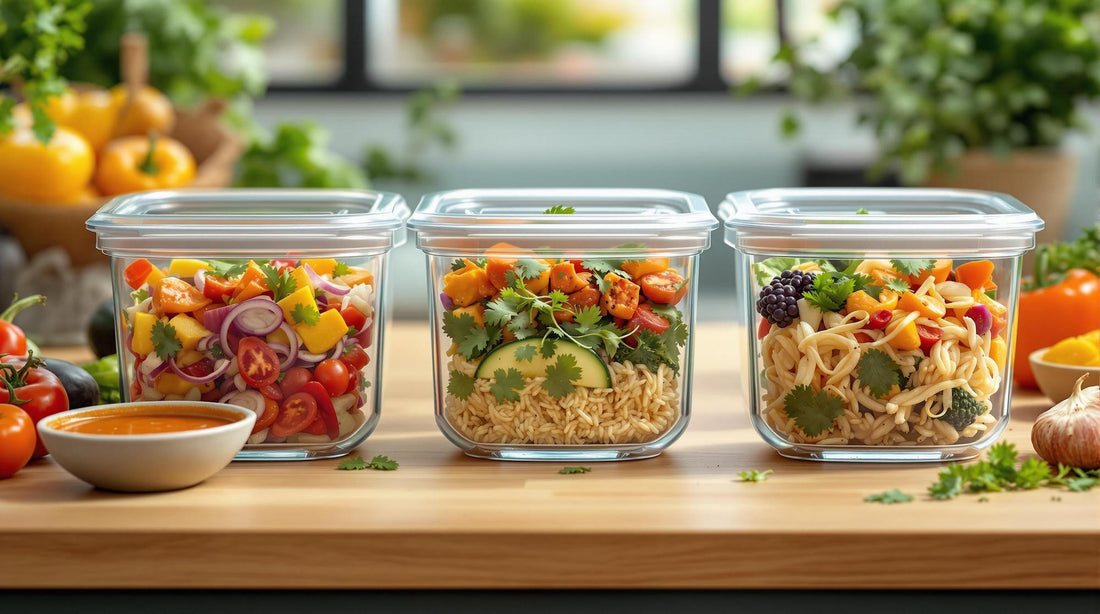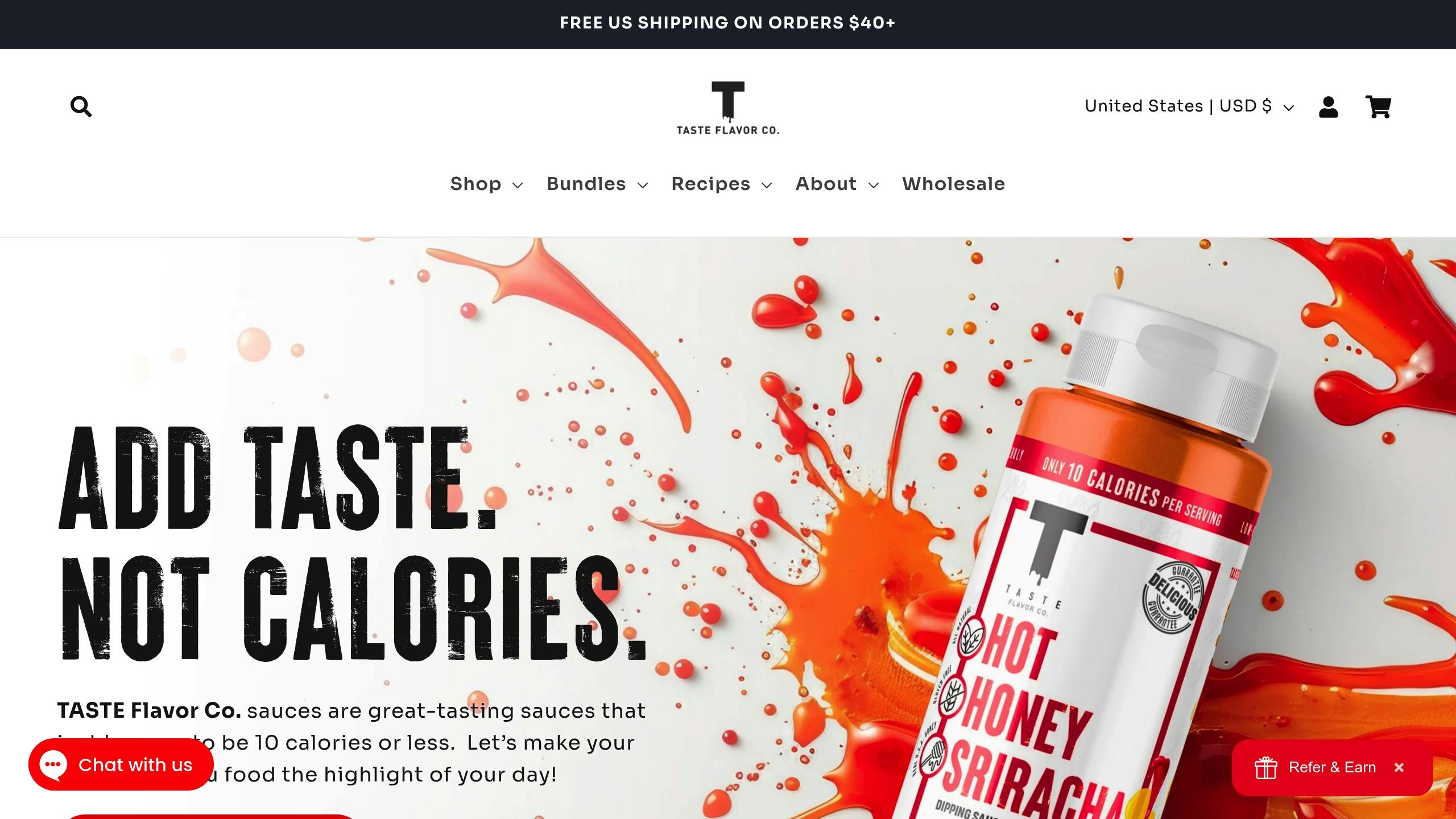
Keto Meal Prep with Zero-Waste Sauces
Share
Want to make keto meal prep easier while reducing food waste? This guide shows you how to create flavorful, low-carb sauces using simple, zero-waste strategies. Here’s what you’ll learn:
- Batch Cooking Basics: Save time by prepping sauces in large quantities and storing them properly.
- Waste Reduction Tips: Turn leftover veggies, herbs, and fats into delicious sauces.
- Store-Bought vs. Homemade: Compare cost, carb content, and waste impact.
- Quick Storage Hacks: Use glass jars, vacuum sealing, and freezing for longer shelf life.
Key takeaway: Smart sauce prep not only keeps your meals keto-friendly but also cuts down on waste and saves money. Let’s dive into the details!
Zero Waste Kitchen Tips: How To Reduce Waste While You Meal Prep
Zero-Waste Keto Sauce Basics
Making keto-friendly sauces with a zero-waste mindset is all about smart preparation and storage. By using some tried-and-true kitchen techniques, you can cut down on waste while keeping your sauces flavorful and fresh.
Batch Cooking Methods
When prepping keto sauces in large batches, start by saving vegetable scraps like onion skins, celery leaves, and carrot tops. Store these trimmings in a container until you have enough to make a broth. This homemade broth can be the base for countless sauces.
Cook 2-4 times your usual amount to create a concentrated base. This approach lets you dilute the base later to suit your needs, giving you flexibility without compromising taste. Once you're done cooking, storage becomes critical to maintain flavor and freshness.
| Sauce Base Type | Shelf Life | Best Storage Method |
|---|---|---|
| Vegetable-based | 3–5 days | Glass containers |
| Cream-based | 5–7 days | Vacuum-sealed bags |
| Oil-based | 1–2 weeks | Dark glass bottles |
| Bone broth-based | 5–7 days | Mason jars |
Smart Storage Tips
Good storage practices are essential for keeping your sauces fresh and reducing waste. Use a First-In-First-Out (FIFO) system to ensure older sauces are used before newer ones. Label containers with the contents and preparation dates using masking tape or washable markers.
Freezing individual portions in silicone trays is another great way to cut down on waste [5]. Here are some quick tips for optimal storage:
- Keep sauces refrigerated at 40°F (4°C) or below.
- Freeze sauces at 0°F (-18°C) to extend their shelf life.
- Use ice cube trays (about 2 tablespoons per cube) for easy portioning.
For cream-based sauces, a vacuum sealer can be a game-changer, as it removes air that speeds up spoilage. Glass containers with airtight lids are perfect for everyday use, while silicone bags are excellent for freezing. These small adjustments can help you store your keto sauces effectively and reduce your environmental footprint.
Store-Bought vs. Homemade Keto Sauces
When it comes to keto meal prep, the choice between store-bought and homemade sauces can have a big impact on both nutrition and waste reduction. Let’s break down the differences to help you decide what works best for your needs.
Sauce Comparison Guide
Store-bought and homemade sauces each come with their own pros and cons. Here’s a quick look at how they compare:
| Aspect | Store-Bought | Homemade |
|---|---|---|
| Carb Content | Varies (e.g., 0–4g net carbs per serving) | Fully customizable based on your recipe |
| Packaging Waste | Often sold in single-use containers | Can be stored in reusable jars or containers |
| Shelf Life | Longer due to preservatives | Fresher but shorter shelf life (freezing helps extend it) |
| Cost | Typically more expensive per serving | More budget-friendly |
| Ingredient Control | Limited to what's in the label | Full control over every ingredient used |
Store-bought sauces tend to last longer thanks to preservatives, but they may not always meet your carb goals. On the other hand, homemade sauces let you tweak recipes to keep carbs low and flavors just right. Plus, research shows homemade tomato sauce has 57% more lycopene than store-bought varieties [1].
By understanding these differences, you can make smarter choices for your keto meal prep while keeping waste in check.
Taste Flavor Co Options

For those leaning toward store-bought options, Taste Flavor Co offers keto-friendly sauces that check a lot of boxes. Their lineup includes five flavors, each with 10 calories or less per serving, making them perfect for meal prep.
Two standout flavors - Hot Honey Sriracha and Spicy Garlic Parm - are especially versatile. They can replace multiple sauces in your kitchen, helping cut down on packaging waste and keeping your pantry clutter-free. Use them as marinades, seasonings, or condiments for a variety of meals throughout the week.
When adding store-bought sauces to your routine, focus on multi-purpose options that simplify your cooking process and reduce waste. A balanced mix of store-bought and homemade sauces can help you stay keto-friendly while minimizing environmental impact.
sbb-itb-f97e3b5
Meal Prep with Keto Sauces
Sauce and Protein Matches
Pairing the right sauce with your protein can make keto meal prep easier and more flavorful. A single sauce can turn one protein into several different meals for the week.
| Protein | Recommended Sauce | Net Carbs | Best Use |
|---|---|---|---|
| Chicken | Garlic Parmesan | 1-2g | Marinade or topping |
| Beef | Mushroom Cream | 2-3g | Pan sauce |
| Fish | Lemon Butter | 0-1g | Finishing sauce |
| Pork | Cherry Smoked BBQ | 2-3g | Glazing or dipping |
For example, Taste Flavor Co's Spicy Garlic Parm sauce is a great match for both chicken and pork. With only 10 calories per serving, it works well as a marinade or a finishing touch, adding flavor without breaking your macros.
If you're prepping fish, a lemon butter sauce is a quick and keto-friendly option. You can whip it up in small batches using leftover butter and fresh lemon juice, keeping your macros in check at about 70-80% fat, 15-25% protein, and 5-10% carbs [4].
By combining these sauce-and-protein pairings with batch cooking, you can streamline your meal prep and cut down on food waste.
Batch Cooking Guide
Batch cooking proteins and vegetables is a practical way to mix and match sauces while saving time.
Start by grilling 6–8 chicken breasts seasoned with just salt and pepper. This creates a neutral base for different sauces throughout the week [2]. Roast large amounts of keto-friendly vegetables like broccoli and cauliflower, then divide them into portions and pair each with a different sauce:
- Toss with garlic parmesan sauce for an Italian-inspired dish.
- Add Hot Honey Sriracha for an Asian-style meal.
- Pair with mushroom cream sauce for a comforting, hearty plate.
To avoid wasting sauces, prepare 2–3 small batches of versatile options. For example, keto-friendly ranch can be portioned into ice cube trays, frozen, and used as needed [7].
Save even more time by marinating portion-sized proteins in keto sauces before freezing. This way, they're pre-seasoned and ready to cook whenever you need them [2].
5 No-Waste Keto Sauce Recipes
Transforming kitchen scraps into keto-friendly sauces is a smart way to cut waste while sticking to your low-carb goals. These recipes use leftover ingredients to create flavorful, nutrient-packed sauces.
Tomato Scrap Sauce
This sauce is a great way to use up overripe tomatoes and vegetable scraps. Roasting the ingredients intensifies their flavors while keeping carbs low.
| Ingredient | Purpose | Net Carbs per Cup |
|---|---|---|
| Overripe tomatoes | Main base | 4g |
| Vegetable ends | Adds flavor | 1-2g |
| Herb stems | Aromatics | 0g |
Here's how to make it: Roast 2 pounds of overripe tomatoes with olive oil, garlic, and herb stems at 400°F for 45 minutes. Once roasted, blend the mixture with 1/4 teaspoon of xanthan gum per cup to thicken. This recipe yields about 3 cups of sauce, with only 4g net carbs per serving [1].
Bone Broth Sauce
Turn leftover bones and meat scraps into a rich, gelatinous sauce that works as a base for various keto dishes. Follow these steps:
- Simmer bones and scraps for 24 hours to extract nutrients.
- Strain the broth and reduce it by half to concentrate flavors.
- Add high-fat ingredients like butter or heavy cream.
- Season with your favorite herbs and spices.
- Use 1 tablespoon of gelatin per cup to thicken.
This sauce is low in carbs and packed with collagen and healthy fats [2]. For storage tips, refer to the Smart Storage Tips section.
Storage and Reheating Tips
Storing and reheating your keto sauces the right way helps maintain their flavor and texture while reducing waste. Here's how you can keep them fresh and ready to enjoy.
Use Glass Containers
Store your sauces in airtight glass containers, such as Mason or Weck jars. These containers are great for preserving freshness and can be stacked to save space. Group similar sauces together and use the First In, First Out (FIFO) method to ensure older batches are used first. While proper storage is key, reheating correctly is just as important to retain the sauce's original taste and texture.
How to Reheat Sauces
Different types of keto sauces need specific reheating techniques:
- Cream-based sauces: Let them sit at room temperature for 15-20 minutes before reheating. Warm gently over low heat, adding a splash of heavy cream while whisking until the temperature reaches 165°F (74°C) [10].
- Tomato-based sauces: Heat on medium-low, stirring often. If the sauce is too thick, add a bit of water or bone broth to adjust the consistency [3].
- Microwave option: Use 50% power in 30-second intervals. Stir and check the temperature until it reaches 165°F (74°C).
For long-term storage, freeze individual portions in silicone ice cube trays. These can last for 4-6 months [6]. If you're using store-bought sauces like Taste Flavor Co, transfer them into 2-oz glass containers for easy portioning [8].
Summary
Effective keto meal prep with minimal waste hinges on thoughtful planning, smart storage techniques, and creative repurposing of ingredients. Proper storage not only helps maintain freshness but also extends the shelf life of sauces.
Take The Keto Kitchen in Austin as an example. By using strategic batch cooking and efficient storage methods, they cut sauce waste by 78%, saved $12,000 in just six months, and boosted customer satisfaction by 22%. Here are two storage methods that stand out:
| Storage Method | Duration | Best Practices |
|---|---|---|
| Glass Containers | 5–7 days | Keep in the coldest part of the fridge |
| Silicone Ice Cube Trays | 3 months | Great for portioning and long-term use |
These practices show how smart storage can make meal prep more efficient while reducing waste.
Mixing homemade sauces with store-bought options, like those from Taste Flavor Co, adds convenience and balance to your meals. Their low-calorie, keto-friendly sauces are designed to save time without sacrificing flavor or nutrition [9].
